
Kung-Fu Master, known as Spartan X in Japan, is a side-scrolling beat 'em up developed by Irem as an arcade video game in 1984, and distributed by Data East in North America. Designed by Takashi Nishiyama, the game was based on Hong Kong martial arts films. It is a loose adaptation of the Jackie Chan, Sammo Hung and Yuen Biao film Wheels on Meals (1984), called Spartan X in Japan, with the protagonist Thomas named after Jackie Chan's character in the film. The game is also heavily inspired by the Bruce Lee film Game of Death (1972), which was the basis for the game's concept. Nishiyama, who had previously designed the side-scrolling shooter Moon Patrol (1982), combined fighting elements with a shoot 'em up gameplay rhythm. Irem and Data East exported the game to the West without the Spartan X license.

Nekketsu Kōha Kunio-kun, released as Renegade in the West, is a beat 'em up video game developed by Technōs Japan and distributed by Taito for the arcades in 1986. In the original Japanese version Nekketsu Kōha Kunio-kun, the game revolves around a high-school delinquent named Kunio-kun who must stand up against a series of rival gangs frequently targeting his classmate Hiroshi. In the Western version Renegade, the player controls a street brawler who must face four different gangs in order to rescue his girlfriend being held captive by a mob boss.
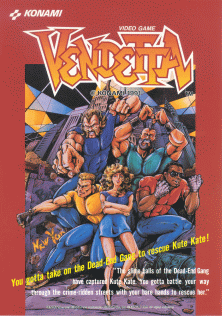
Vendetta, known in Japan as Crime Fighters 2 (クライムファイターズ2), is a 1991 side-scrolling beat-'em-up arcade game developed and published by Konami. It is the sequel to 1989 Konami's Crime Fighters, although it was marketed internationally as a stand-alone game with no previous connections.

The Simpsons is an arcade beat 'em up developed and published by Konami released in 1991. It was the first video game based on the Simpsons franchise to be released in North America. The game allows up to four players to control members of the Simpson family as they fight various enemies to rescue the kidnapped Maggie. It was a commercial success in the United States, where it was one of the top three best-selling arcade video game machines of 1991, The game also features the television shows's voice actors; Dan Castellaneta, Julie Kavner, Nancy Cartwright and Yeardley Smith reprising their respective roles as the Simpsons family.

Teenage Mutant Ninja Turtles: Turtles in Time, released as Teenage Mutant Hero Turtles: Turtles in Time in Europe, is a beat 'em up arcade video game produced by Konami and released in 1991. A sequel to the original Teenage Mutant Ninja Turtles arcade game, it is a scrolling beat 'em up type game based mainly on the 1987 TMNT animated series. Originally an arcade game, Turtles in Time was ported to the Super Nintendo Entertainment System in 1992 under the title Teenage Mutant Ninja Turtles IV: Turtles in Time, continuing the numbering from the earlier Turtles games released on the original NES. That same year, a game that borrowed many elements, Teenage Mutant Ninja Turtles: The Hyperstone Heist, was released for the Sega Genesis.

Teenage Mutant Ninja Turtles: The Hyperstone Heist, released in Europe as Teenage Mutant Hero Turtles: The Hyperstone Heist and in Japan as Teenage Mutant Ninja Turtles: Return of the Shredder, is a 1992 side-scrolling beat 'em up game developed and published by Konami for the Sega Genesis, based on the Teenage Mutant Ninja Turtles comic book characters. It was Konami's debut title for the Genesis. The game was re-released as part of Teenage Mutant Ninja Turtles: The Cowabunga Collection in 2022.

Double Dragon III: The Sacred Stones, released in Japan as Double Dragon III: The Rosetta Stone (ダブルドラゴンIII ザ・ロゼッタストーン), is a side-scrolling beat-'em-up produced for the Nintendo Entertainment System in 1991. It was the third Double Dragon game for the NES, developed by Technos Japan Corp. and published in North America and Europe by Acclaim Entertainment. Although loosely based on the similarly titled arcade game Double Dragon 3: The Rosetta Stone, it is not a port, but a parallel project that was developed at the same time.

Teenage Mutant Ninja Turtles III: The Manhattan Project is a side-scrolling beat-'em-up released by Konami for the Family Computer (Famicom) in Japan in 1991 and for the Nintendo Entertainment System in North America in 1992. It is the third video game iteration of the Teenage Mutant Ninja Turtles for the NES. The game features play mechanics similar to the previous game, Teenage Mutant Ninja Turtles II: The Arcade Game, but it is an original title for the NES without any preceding arcade version. It is based on the 1987 Teenage Mutant Ninja Turtles animated series, being released after the show's 5th season. The game was re-released as part of Teenage Mutant Ninja Turtles: The Cowabunga Collection in 2022.

Yie Ar Kung-Fu is an arcade fighting game developed and published by Konami. It first had a limited Japanese release in October 1984, before having a wide release nationwide in January 1985 and then internationally in March. Along with Karate Champ (1984), which influenced Yie-Ar Kung Fu, it is one of the games that established the basis for modern fighting games.
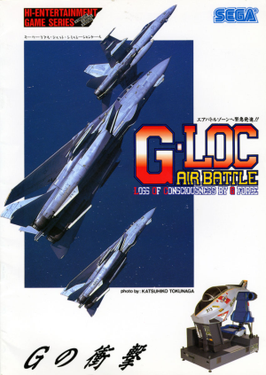
G-LOC: Air Battle is a 1990 combat flight simulator arcade video game developed and published by Sega. It is a spin-off of the company's After Burner series. The title refers to "G-force induced Loss Of Consciousness". The game is known for its use of the R360 motion simulator arcade cabinet. The arcade game was a commercial and critical success upon release.

Teenage Mutant Ninja Turtles: Tournament Fighters, or Teenage Mutant Hero Turtles: Tournament Fighters in Europe, is the title of three different fighting games based on the Teenage Mutant Ninja Turtles, produced by Konami for the Nintendo Entertainment System, Sega Genesis, and Super NES and released during a period between 1993 and 1994. Konami produced a different fighting game based on the franchise each featuring a differing cast of characters for the platforms. All three versions of the game were re-released as part of Teenage Mutant Ninja Turtles: The Cowabunga Collection in 2022. with online play using rollback netcode for the SNES version of the game.

Teenage Mutant Ninja Turtles, known as Geki Kame Ninja Den in Japan and Teenage Mutant Hero Turtles in Europe, is a 1989 side-scrolling action-platform game for the Nintendo Entertainment System released by Konami. In North America it was published under Konami's Ultra Games imprint in the US and the equivalent PALCOM brand in Europe and Australia.
A beat 'em up is a video game genre featuring hand-to-hand combat against a large number of opponents. Traditional beat 'em ups take place in scrolling, two-dimensional (2D) levels, while a number of modern games feature more open three-dimensional (3D) environments with yet larger numbers of enemies. The gameplay tends to follow arcade genre conventions, such as being simple to learn but difficult to master, and the combat system tends to be more highly developed than other side-scrolling action games. Two-player cooperative gameplay and multiple player characters are also hallmarks of the genre. Most of these games take place in urban settings and feature crime-fighting and revenge-based plots, though some games may employ historical, science fiction or fantasy themes.
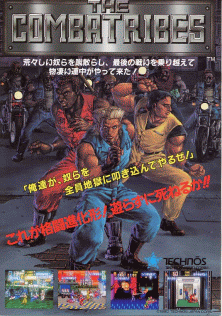
The Combatribes is a 1990 beat 'em-up game released for the arcades by Technos Japan Corp. A home version for the Super Nintendo Entertainment System was also released in 1992. The game centers on three vigilantes who must fight against numerous street gangs in futuristic New York City. The SNES version was released for the Wii Virtual Console in North America on November 30, 2009.

Metamorphic Force is an arcade game released by Konami in August 1993. It is one of Konami's last side-scrolling Beat 'em up games to appear in the arcades along Violent Storm.
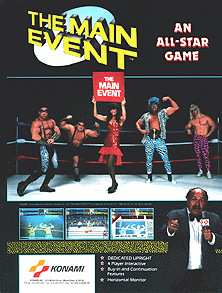
The Main Event, known in Japan as Ringu no Ōja, is a professional wrestling arcade game released by Konami in 1988.

Growl, known in Japan as Runark, is a belt-scrolling beat-'em-up originally released for the arcades by Taito in 1990. Set in the early 20th century, the player controls a forest ranger who must protect the local wildlife from a group of evil poachers who are driving the animals to extinction. A home version was released for the Sega Genesis in November 1991. It was also included in the arcade game compilation Taito Legends 2 for the PlayStation 2, Xbox and Microsoft Windows.
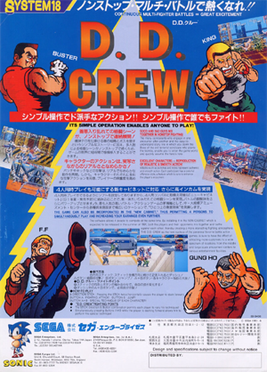
D. D. Crew is a 1991 2D beat 'em up arcade video game developed and released by Sega.

Captain Commando is a 1991 futuristic side-scrolling beat 'em up originally developed and published by Capcom as an arcade video game, and later ported to several other platforms. It was the seventeenth game produced for the company's CP System hardware. The game stars the titular superhero who was originally conceived as a fictional spokesman used by Capcom USA in the company's console games during the late 1980s. The game was included in Capcom Beat 'Em Up Bundle compilation title, which was released digitally for Nintendo Switch, PlayStation 4, Xbox One, and Windows on September 18, 2018.

Teenage Mutant Ninja Turtles, released in Japan as TMNT: Super Kame Ninja and in Europe as Teenage Mutant Hero Turtles, is a 1989 beat 'em up arcade game released by Konami. It is based on the Teenage Mutant Ninja Turtles franchise, including the first animated series that began airing two years earlier. In the game, up to four players control the titular Ninja Turtles, fighting through various levels to defeat the turtles' enemies, including the Shredder, Krang and the Foot Clan. Released during a high point in popularity for the Teenage Mutant Ninja Turtles franchise, the arcade game was a worldwide hit, becoming the highest-grossing dedicated arcade game of 1990 in the United States and Konami's highest-grossing arcade game. Versions for various home systems soon followed, including the Nintendo Entertainment System. A sequel, Teenage Mutant Ninja Turtles: Turtles in Time, was released in 1991.



















